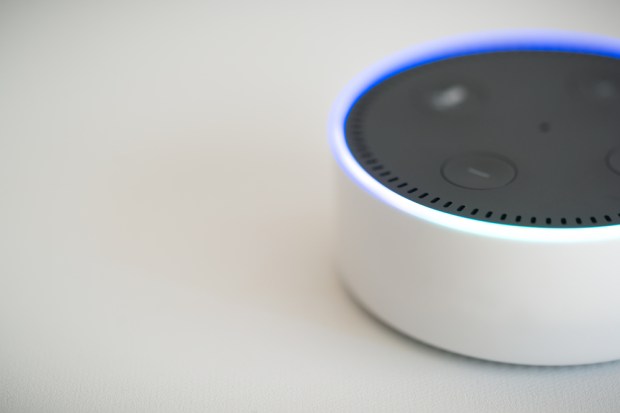Alexa Is The New Virtual Roommate

An increasing number of consumers are getting a roommate, and her name is Alexa.
She’s smart, and she’s also learning. Between 2017 and the beginning of 2018, the number of Alexa skills skyrocketed to more than 25,000 from 7,053 in the U.S. and have increased a little more than 100 percent in the U.K over the same period.
Amazon’s assistant has also become more well-known and popular. In December 2017, Royal Bank of Canada (RBC) reported awareness about Amazon and Alexa had jumped to 89 percent over the previous nine months, up from 77 percent. In addition, 14 percent of respondents to a June 2017 How We Will Pay survey by PYMNTS and Visa said they owned an Amazon Echo speaker or a Google Home Assistant.
With her skills seemingly growing each day, and her audience getting ever-larger, original equipment manufacturers (OEMs) are putting Alexa to work all in smart devices over the house. In short, Alexa is moving in — and taking over every room.
Bedroom
Alexa can power smart mattress technology. Sleep tech startup Eight has an Alexa skill that allows users to control mattress temperature and access sleep data through its line of mattresses.
Amazon has also been connecting with consumers in this area of the home by allowing them to wake up to tunes from its Prime Music or Amazon Music Unlimited services in addition to Spotify, Pandora and other streaming options. The skill is designed to send light sleepers to Amazon’s own music platform. Those who wish to request a wake-up song by its lyrics must use Amazon Music.
There’s also another option for those wishing to use Alexa to wake up. The Echo Spot — with its camera, display and speaker — is essentially designed as an alarm clock.
Kitchen
While Alexa may not be able to prepare a five-course meal — at least not yet — she does allow consumers to interact with kitchen appliances. The smart assistant can connect to the $299 Behmor Connected Coffee Brewer, for example, which will respond to commands such as, “Alexa, ask Behmor to brew my coffee.”
Aside from consumer convenience, the connected coffee machine offers a retail avenue for Amazon. It can autonomously reorder them from Amazon’s site through its growing Dash Replenishment program when the supply of coffee beans runs low. With the program, smart devices like coffee makers can measure product consumption through a variety of inputs — including infrared, pressure flow, weight and other sensor arrays — which triggers an automatic reorder from Amazon before supplies run out.
Beyond coffee makers, Alexa has been making her way onto other kitchen appliances, too. A collaboration between GE and Monogram has been getting into the Alexa game through the Geneva line. Consumers can use and control their Geneva appliances, including ovens and water heaters, through Alexa commands.
LG is getting into the Alexa appliance business, too. The appliance maker announced an InstaView ThinQ Refrigerator at this year’s Consumer Electronics Show (CES), an appliance that uses artificial intelligence (AI) to decide which instructions to send to other appliances like an oven or dishwasher.
But Alexa is not the only AI assistant that comes as a built-in feature for kitchen appliances. Samsung is bucking the Alexa trend by putting its own assistant, Bixby, into its Hub fridges. The news comes a few months after Samsung’s executive vice president Eui-Suk Chung noted, “Bixby 2.0 will be ubiquitous, available on any and all devices” — seemingly just like Alexa.
Laundry Room
Laundry room appliances are also Alexa-enabled. Washing machines with Home Connect, for example, allow consumers to start or stop a wash through voice command.
The service suggests an ideal washing and drying program, too, and it can apply settings that can’t be commonly found on some washing machines — such as those to remove stains. It can also take water hardness and load size into account to automatically determine the appropriate amount of detergent and fabric softener.
Consumers needing further advice can turn to the Tide Stain Remover skill, which offers step-by-step instructors for removing stains from clothes and, includes a Tide product recommendation, of course.
Living Room
“Alexa, let’s watch Castle.’’ DISH TV has made that command a reality with its “hands-free TV.” Using Alexa, DISH subscribers can control all TVs in the Hopper whole-home ecosystem by pairing each set-top box with an Amazon Echo, Echo Show or Echo Dot.
Using the DISH skill, Alexa can navigate, play, pause, fast-forward, rewind and search content based on channel, title, actor, genre or sports team — and DISH is able to steer viewers to its live, recorded and on-demand titles, as well as Netflix’s selection of TV shows and movies.
For customers without DISH access, Alexa is also on Amazon’s Fire TV. Through a 2017 update, users can now tell Alexa to play, pause, rewind and fast-forward, and she can open apps and search Amazon’s catalog of movies and TV shows on command.
In addition, Alexa continues her march toward integration into television as LG plans to deliver smart TVs with built-in support for both Google Assistant and Alexa soon.
Game Room
In the game room, Hasbro has brought Trivial Pursuit to Alexa. The voice-assistant version of the popular board game allows consumers to create game show competitions at home using Echo Button devices as buzzers that light up in different colors. The skill also marks a first for Amazon: It’s the first major board game to be adapted for Alexa with the ability to use the Echo Button.
The Closet
Amazon has made Alexa into a fashion expert with Echo Look, but it is only available for select customers by invitation only. Unlike the Echo devices that came before it, the Echo Look has a camera — making it the first to both see and hear.
Echo Look allows users to take full-length photographs and videos of themselves, then analyzes the results so Alexa can provide fashion advice through “machine learning algorithms with advice from fashion specialists,” Inc. reported.
Bathroom
Mirror, mirror on the wall, who’s the smartest mirror of them all? That could be Kohler’s Verdera Voice Lighted Mirror, the first Amazon Alexa-enabled mirror. Verdera is surrounded by LED lights, which consumers can control with Alexa, and it comes enabled with tens of thousands of Alexa skills — meaning consumers can hear the news or weather.
But Verdera is not the only mirror in town. The HiMirror, which was on display at CES this year, photographs and scans a user’s face for imperfections, then returns instructions about the elements on which the user needs to work.
Kohler also has a perfect fill tub. Using Alexa, consumers can automatically turn on the tub’s faucet, adjust its temperature and shut it off when its full.
From Roommate To Copilot
So, where is Alexa headed next? To the commute.
Several automakers — including Toyota, Ford and BMW, among others — have announced they would add Alexa as a built-in feature on their cars. To make Alexa’s integration into vehicles easier, Amazon released an Alexa Onboard technology platform to allow users to access Alexa through car infotainment systems.
Using the platform, riders will be able to play music, ask for directions or control the car’s lighting and other internal systems simply by speaking to the audio system. They can also shop, of course. Using Ford’s technology, drivers will be able to add items to their Amazon shopping lists and even purchase those items from inside their vehicles.
Alexa’s march into the automobile industry also got a big boost this fall when it announced a pair-up with navigation giant Garmin in launching the Garmin Speak, a device similar to the Amazon Echo that is powered by Alexa. The goal was to combine Alexa’s intelligence and usefulness with all of Garmin’s navigation prowess, making it easy for customers to multitask while driving without looking at their phones. But there’s a caveat: Drivers still have to keep their hands on the wheel as Alexa can’t steer — at least not yet.
